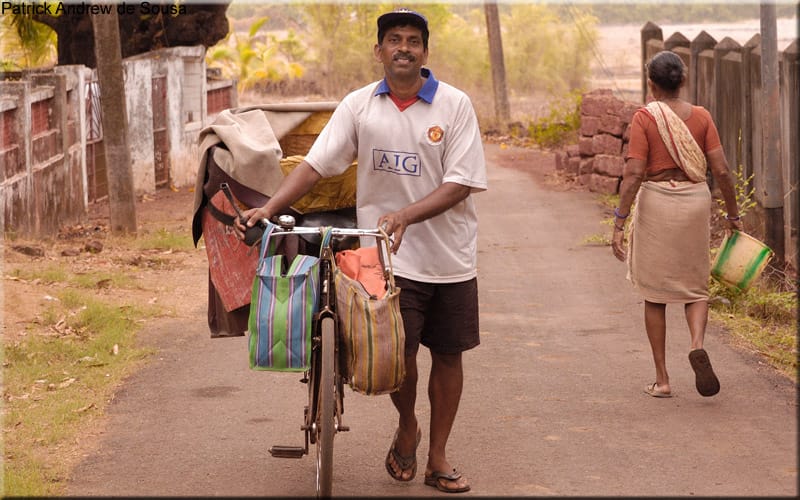



In Goa, the trill of the bicycle of the poder (bread vendor) has replaced the alarm clock for many. Thus delivered, the still warm bread is unwrapped from the newspaper and buttered generously before dunking it in chau (tea in Konkani) or eaten with kalchi kodi (previous day’s curry). Goa is a land of bread eaters, and pao is a way of life.
When pao came to India
The story of pao began when the bread-loving Portuguese entered Goa 500 years ago. They missed their bread, not just on the plate but also for Holy Communion. But there was no yeast. How do you make bread without yeast? Enter toddy. The ingenious Portuguese experimented with toddy and the Goan pao was born.
Pao is Portuguese for bread, and the Goan bread-maker is known locally as poder, an adaptation of the Portuguese padeiro. “The toddy, locally known as sur, used to leaven the bread, gave it a distinctive character that is quite impossible to replicate with any other kind of yeast. This dough was then left to ferment for 2-3 hours before baking in wood-fired mud ovens known as forn. These breads could last for five to six days, and were eaten as toast or also made into breadcrumbs which was then used in making fish fries, cutlets, etc.,” says Paul Noronha, executive chef, ITC Grand Central.
Over the years, the use of toddy slowly dwindled, and yeast was introduced as it was found to be more economical and profitable. Bakers today use wet yeast instead of toddy as the leavening agent as this reduces the time it takes for the dough to rise.
Bread-making in Goa has for centuries been the province of the Catholic community. It is a family tradition handed down generations, with the entire clan involved in the operation. Every village has its own bakery or two where you can haul pao straight from the furnace.
“Although...the style of breads remains the same across Goa, different poders have their own recipes and baking styles. Some of them use psyllium husk, wheat bran, broken wheat, rice starch, banana, etc. But what separates them majorly is the art and method of fermentation,” says Aabhas Mehrotra, culinary director, W Goa.
The pao travelled to Bombay (now Mumbai) with the Goan bakers who migrated there. Remember, Bombay was handed over by the Portuguese to the British as dowry on the occasion of Catherine of Braganza’s marriage to Charles II of England. This could have been one of the reasons for this migration of Goan bakers and their craft. That explains how the Goans who migrated to Bombay earned the sobriquet “pavvallas” and as “macapao” (literally meaning “give me bread” in Konkani). Pao quickly found it place in the city’s culinary landscape as pav bhaji, vada pav, missal pav, etc.
 A poder on his morning rounds. (Picture courtesy Patrick De Sousa)
A poder on his morning rounds. (Picture courtesy Patrick De Sousa)
Meet unndo, kankonn and kator
While the soft and chewy pao is the most popular, the flat and round poiee with a thin layer of wheat husk is equally sought after. “Think of the poiee as the pita’s cousin. It’s generally had with traditional Portuguese curries and vindaloos. But it matches best with ros omelette. I love to stuff the poiee-pocket with Goan sausages or minced meat,” says local IT professional and local Jacob Rodrigues.
Then there is the ring-shaped bread called kankonn. This bread gets its name from the Konkani word for bangles, since it resembles the shape. Kankonn dipped in hot chai is a favourite tea time snack.
Another variety that gets its name from a Konkani word is katre pao or katricho pao (derived from kator, which means to cut). The dough is cut and shaped by scissors. This butterfly-shaped bread is preferred with bhajis and ros omelet (omelet in spicy gravy).
In the baking hierarchy, poiee goes in first because it needs the most heat and bakes the fastest – just two minutes. Katre pao takes about five minutes while the square pao comes out golden and fluffy in eight minutes. Depending on the heat, the kankonn might take 15-20 minutes to come out crisp and brown.
 Goa has at least 15 varieties of artisanal bread. (Image: Jonas Kakaroto via Unsplash)
Goa has at least 15 varieties of artisanal bread. (Image: Jonas Kakaroto via Unsplash)
Dough or die
Dwindling demand for traditional breads is making it hard for the poders to get by. A combination of rising costs and meagre profits along with the intensive labour involved in making bread have led to the younger generation shunning the Goan family business of bread-making. The regulation on the minimum price of bread (Rs 5 a piece) is another deterrent.
“The number of poders in Goa is dwindling as the cost of the traditionally used toddy has increased. Newer commercial bakeries are being set up which are capable of producing higher quantities at a lower price,” explains Noronha.
More worrisome is that it is very difficult to find artisans who can repair or even build the wood-fired mud ovens. Thankfully, both fine-dine restaurants and 5 star hotels in Goa are now serving these breads as morning breakfast staples and as accompaniments to Goan delicacies.
“The pao is now evolving. Yeast is being substituted with starters such as poolish, a version of sourdough starter, and biga, a type of preferment. Even the type of flour used is undergoing a change, with demand for whole wheat bread on the rise. This has given rise to a more refined product and the demand is surely going to grow,” assures W Goa's Mehrotra.
Discover the latest Business News, Sensex, and Nifty updates. Obtain Personal Finance insights, tax queries, and expert opinions on Moneycontrol or download the Moneycontrol App to stay updated!
Find the best of Al News in one place, specially curated for you every weekend.
Stay on top of the latest tech trends and biggest startup news.